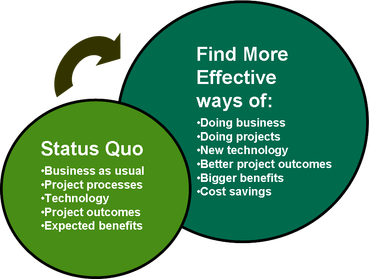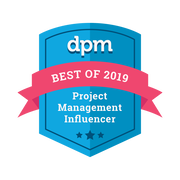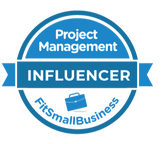How to Become a Project Leader by Challenging the Status Quo
When you challenge the status quo, it means that you identify new and better ways of doing things on behalf of your project, your client and your organisation. It also means that you add value, and that’s the very basis for being successful. In order for you to step up and become a project management leader, you must add more value than anyone else. It is not enough to just turn up and do a good job. We have to stay competitive and consistently look for new and better ways of doing business, saving money and adding benefits to our customers.
1. See things the way they are.
The first step is to have a realistic and accurate understanding of today’s
state of play. What are the project processes, technology and company procedures you currently make use of? What are the business processes that your client follows on a daily basis and what are the expected benefits from your project? These aspects represent the status quo. It is how you normally go about things and how you usually execute projects. It is also how your client normally does business.
2. See things better than they are.
The second step is to have the vision and ability to see a better future than
what currently is. Be inspired and imagine what the future would look like if
you made use of more simplified processes, new and better technology, were able to build a highly motivated team, had better relationships with your customers, and if you were able to improve the way they do business. Look at the end game; that of adding value to your client in a faster, cheaper and better way. Then identify the gaps between the end game and the current state. These gaps represent opportunities for improvements, and opportunities for you to step up and lead!
3. Implement your view of the future.
When you have a clear vision of how your project and team can add more value and work more effectively, the third step is to believe in your vision and make it happen. Be the champion and seek to motivate others to help you implement the vision. Paint an appealing picture of the future and make people understand what’s in it for them. They will be more supportive and willing to follow when you demonstrate how they fit into the vision and what the benefits are to their career and reputation of delivering more value in a faster, cheaper and better way.
One of the best ways of bringing about this mindset shift is to regularly take a step back and ask a set of insightful questions. Set time aside in your diary and allow yourself to get away from your desk for 30 to 60 minutes. Go to a place where you feel inspired and where you will not be disturbed. Take a “balcony” view of the project and observe it from afar. What is working well and what is not working so well? How could you run it in a more successful and effective manner? How could you help your client get more benefit and maybe even save money in the process? How could you improve customer satisfaction and team motivation?
Another good way of challenging the status quo is to ask open questions of your team members whenever you get the chance. Ask them how they feel you can work more effectively as a team, how you can improve quality and what they think the biggest unaddressed risks are. This approach is excellent for engaging and empowering people and for changing the mindset of the entire team.
When you consistently challenge the status quo, you have the potential of unlimited success, because you add an unlimited amount of value. You also have the potential to demonstrate your leadership skills, because you make things happen based on your vision. Thought leaders are not satisfied with following others or doing a “good” job. They are committed to excellence
and they see things better than they are. They make their own models of how things should be and are brave enough to implement these models.
Questions:
>>On a scale from 1-10, how good are you at adding value every single day?
>>How can you start to challenge the status quo right now?
For a list of insightful questions to ask yourself and others, download the “Power of Questions” worksheet from the RESOURCES page. You can request access for free here.
If you liked this post you might also like:
16 Essential Questions to Project Leadership Success
20 Essential Tips for Project Leaders
Delegate Effectively and Thoughtfully
Be a Project Champion









 RSS Feed
RSS Feed